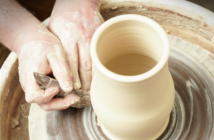The Wonders of Peat Moss
By Steve Zimmerman
Brisk mornings, sunny afternoons, and the onset of the colorful fall foliage make for an absolutely delightful time to be outside pursuing fall gardening projects. Regardless of whether you are spot seeding your lawn, planting mums, or finally installing that large shade tree, in more cases than not, here in Adams County, it is strongly encouraged to consider amending the soil for best results. Peat moss is one of the soil conditioners I encourage the use of in almost any planting project.
So what exactly is peat moss, and why should I add it to my soil? Peat moss is simply decomposing moss. Sphagnum mosses are found in bogs in the cold, wet regions of Michigan, throughout Canada, and in Europe. Sphagnum moss was one of the first plants to grow on land after the Ice Age glaciers melted. Since the Ice Age, layers of slowly decomposing sphagnum moss has accumulated in these bogs.
Sphagnum moss, of which there are several varieties, has been used for many years. This living moss that grows on the top of the bog is used widely in the floral industry for wreaths and to line hanging baskets. And, during World War I, medical personnel used sphagnum moss soaked with a garlic solution to treat wounds.
Peat moss is the slowly decaying layers found under sphagnum moss. Peat moss is harvested by draining the bogs, removing the top living layer, and allowing the under layer to dry. The dried sphagnum is then removed by harvester vacuums at a rate of 3/8 inch at a time. During harvest season, between 2 and 5 inches of peat moss will be removed from the bog. Enough moss is always left behind so the natural vegetation can easily be restored. Canada has more than 270 million acres of bog and only .02 percent is harvested. And peat moss accumulates at approximately 70 times its harvest rate. This makes for a very environmentally sustainable harvesting process.
Why should we add peat moss as a soil conditioner? The answer is actually quite simple: peat moss improves soil. It is able to do this because of its ability to retain a lot of water while still remaining very porous. Peat moss can absorb as much as 20 times its weight in liquid and still, after being thoroughly saturated, contain 15 percent air space. This ability to permit an excellent exchange of air and water is tremendously beneficial to plant material. Simply stated, peat moss will help any type of soil hold moisture and drain well at the same time. This means it will help aerate heavy clay soil and also can help bind sandy soil.
Peat moss is very acidic, usually between 3.5 and 4.5 pH. Keep in mind, peat moss is a soil conditioner only;
it does not add any nutritional value to the soil. It does, however, reduce the leaching of nutrients that are already in or that have been added to the soil.
In local garden centers, peat moss will most likely be available in bales. These will range in size from 2.8 to 3.8 cubic feet. These bales are compressed; when opened they will expand to approximately twice the packaged amount. Peat moss should be used at the rate of 2 inches of peat tilled into the top 6 inches of soil. A 3.8 cubic foot bale will cover approximately 90 square feet of garden.
Peat moss also helps to accelerate the composting process. Those of you who compost may want to add some peat moss while mixing and turning your piles. Adding it will speed up the process, reduce odor, and help regulate the air and water balance in your compost pile.
Peat moss is clean, environmentally friendly, all natural, and free of weed seeds, harmful salts, chemicals, and even insects. What a wonderful, natural gift!
Steve and Laurie Zimmerman have owned and operated Zimmerman’s Azalea Gardens and Landscaping in Adams County since 1992. Visit their website at www.zaglandscaping.com.




